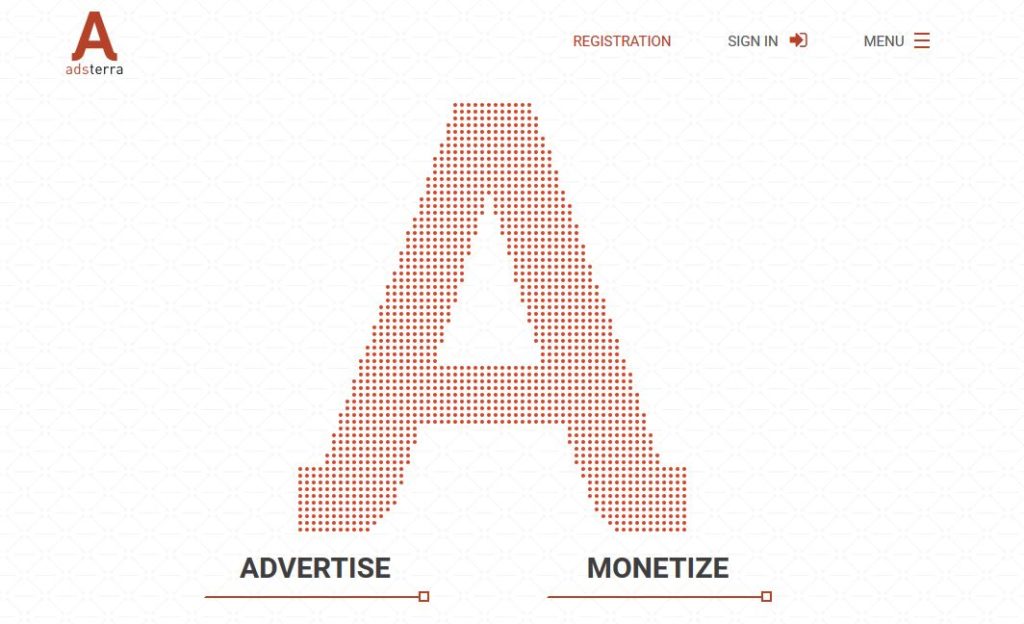In the early days of the Internet, ads were seen as an eyesore for websites. Not only did they affect the look of web pages, but they also had a knack for decreasing performance. They often turned websites into clunky digital spaces that took forever to load.
A lot has changed since then. I have seen the transformation of the digital advertising landscape firsthand. Gone are the days when ads were considered nothing more than mere eyesores on websites, negatively impacting both aesthetics and performance.
Today, through my own personal experience, I have come to understand that digital advertisements have evolved into an important part of the puzzle. Web users have grown accustomed to seeing them and website owners rely on them to make a profit. They’re an important monetization tool that many businesses rely on to stay afloat, although there are plenty of free advertising opportunities online.
While the placement of ads may seem arbitrary, there’s a lot of careful strategies involved. There’s a fine line between affecting the user experience and implementing successful ads that aren’t intrusive. Striking the perfect balance between enhancing user experience and implementing effective, non-intrusive ads is key to achieving higher click-through rates and successful monetization.
Why Are Ads Important?
Online advertising is not a niche industry by any means. Companies can spend millions of dollars just to gain exposure and increase sales. From an advertiser front, digital ads hold a greater weight than traditional marketing techniques.
A significant portion of advertising budgets goes into advertising on social media and websites. It’s not hard to see why. Big-name sites can attract millions of visitors a day. While traditional marketing methods like billboards and television spots are still important, online advertising offers greater control over who sees an ad.
In my professional experience, the ability to leverage analytics and traffic data has revolutionized advertising. This allows advertisers to collaborate with websites that cater to their target audience, thereby increasing conversion rates and the likelihood of generating sales.
So, what kinds of businesses are benefitting from online marketing?
Any business can take advantage of this unique form of marketing. Typically, it’s used most by eCommerce platforms looking to increase sales or gain more brand awareness. However, you can also see ads for professionals, business-to-business organizations, and more.
The Importance of Ads for Publishers
Have you ever wondered how sites can be profitable when they are offering a free product? It all comes down to selling ad space.
Many different types of sites rely on ads to continue making revenue. This includes news sites, blogs, and even content creators. It’s the primary source of income for many big-name sites that you visit every day.
As a website gains more traffic, they’re able to charge more for ad space. Higher pageviews lead to more exposure for brands. It’s a snowball effect with virtually no limit. As long as the website continues to get traffic, there’s always a possibility for monetization.
Available Ad Providers
When a website owner, blogger or developer has created a website and is ready to start monetizing their success, there are several ways to do it. Typically, they’ll work with ad networks. Ad providers act as the middle man between the advertiser and the publisher.
These ad providers offer several unique services to both parties involved. They can help sites reach their full potential, improve their search engine performance, and ultimately gain more traffic. This can benefit advertisers who are looking to work gain more click-through traffic of their own. Here are some of the most popular ad networks available.
Ezoic
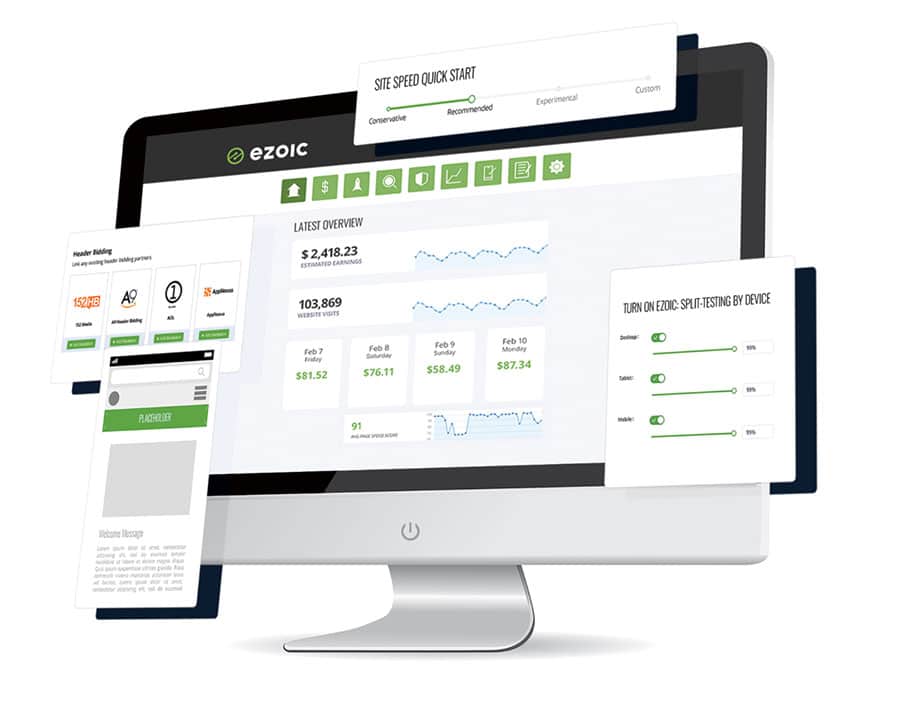
Ezoic is aimed at becoming an all-in-one network for sites and advertisers. Not only does it connect the two parties for successful monetization, but the platform also makes it easy for developers to manage advertising space.
The application and Ezoic dashboard allow you to view analytics in real time. Not only that, but built-in tools help you make the most out of your ad placement. You can test ad layouts and optimize code to ensure that performance doesn’t suffer due to interactive banners. It works on all content management systems and can even be used to fully optimize your advertising efforts for mobile devices.
Google AdSense

Google AdSense is, perhaps, one of the most well-known networks on the web. It’s used by hundreds of thousands of sites and advertisers. Like other networks, Google AdSense can connect you with businesses vying for advertising space. It’s relatively easy to set up and takes care of many of the management tasks for you.
Google AdSense is not as feature-rich as Ezoic. However, it does offer some simplification features to take the hard work out of digital advertisers. For example, the application will automatically present you with ads based on your site’s layout and content. You can then customize the user experience by choosing what works best for your audience. This is a great option for those who are planning to start a blog and are looking for potential ways to monetize their blogs.
AdSterra
The Adsterra network has a lot to offer both advertisers and publishers. For advertisers, the provider utilizes many smart targeting features to find sites that are suitable for the target demographic. All of the ads are optimized for mobile devices for maximum impact.
On the publishing front, Adsterra makes the monetization process very simple. All you have to do is implement some code into your site to start earning. All ads go through a security and fraud detection system to check for malware. The network also offers high CPM rates and effective ad formats that work for your site.
Mediavine
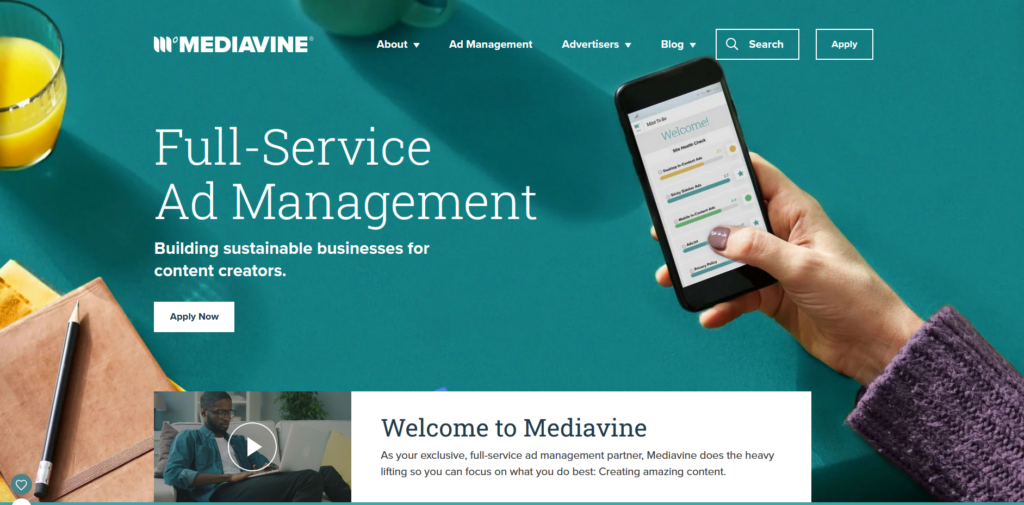
Mediavine is a great Google AdSense alternative. In fact, many website owners and bloggers prefer Mediavine over AdSense due to its high payouts and advanced ad management features.
Unlike AdSense, Mediavine requires website owners to have a minimum of 50,000 monthly sessions before they can apply to join the platform. However, once approved, you can expect to receive higher payouts than you would with AdSense. This is partly due to Mediavine’s premium ad inventory and advanced ad targeting technology.
They use a method called ‘lazy loading’ to prevent your website slowing down while the ads load. Your page will load first, the ads after. Mediavine also provides you with a suite of ad management tools, including comprehensive reporting and analytics.
Types Of Online Advertisements
Placing ads on a website is not a one-size-fits-all situation. Remember, the goal of online advertising is to put effective ads in front of the right people without obstructing the core content of the web page.
The key is to implement many different types of ads into a page. Doing so allows you to influence visitors without being too in-your-face. The types of advertisements you can use will also largely depend on the goals of the advertiser. Here are the most common types of ads advertisers will use.
Direct Display Ads
Display ads are the most obvious form of advertising. Basically, they’re digital billboards implemented into the site’s design. They can be placed in many different spots to increase effectiveness. We’ll get into that a bit later.
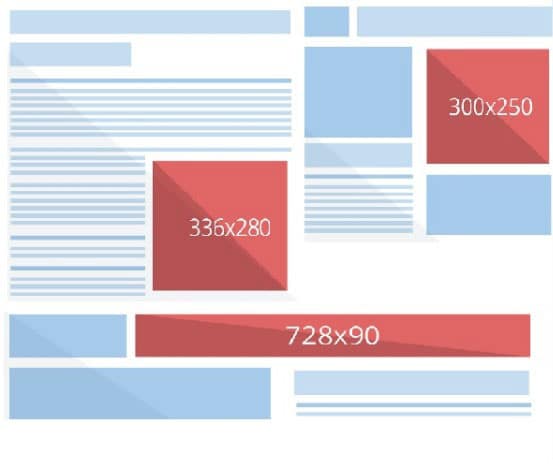
However, the most common is at the page header or on the sidebar. Display ads are relatively simple to implement, making them a popular choice among publishers.
Native Advertisements
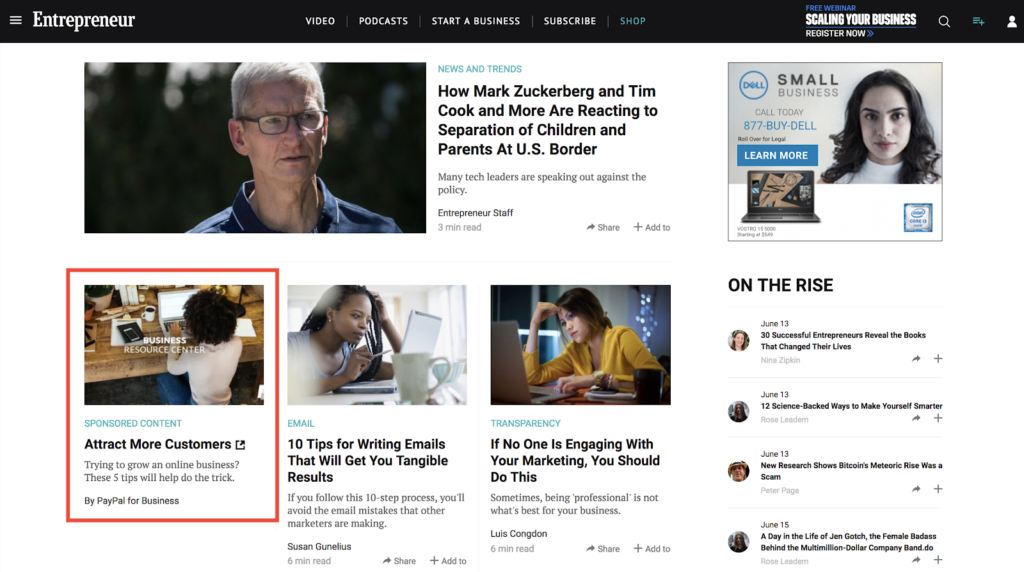
Publishers looking to take a more subtle approach to monetization can go with native advertisements. While display ads are out in the open and ready to see, native ads are integrated into the content. They may come in the form of sponsored content or advertorials. Usually, most native ads are matched to the specific platform they’re on. So, advertisers work a bit closer with publishers to ensure that it’s a seamless fit.
Affiliate Ads
Affiliate ads are another subtle form of marketing. It’s very common with marketplace sites like Amazon. Rather than utilizing traditional visual banners, affiliate ads involve creating direct links to the advertiser’s web page. Publishers can then make money for every sale or lead generation.
Interactive Ads
Finally, we have interactive ads. Interactive ads tend to be the most obtrusive. However, they can be worked into a site’s design strategically. They can come in the form of pop-ups, interactive scrolls, or even videos.
Where Are Ads Placed?
As we mentioned earlier, there’s a delicate balance between displaying ads and providing the content visitors are after. The goal is to implement ads in a way that does not negatively impact the user.
There are many strategies to do this. However, web designers will usually put ads in spots on the page where the eyeballs naturally go. Random spots on the page that people won’t even look at aren’t effective. Thus, your ad revenue will not reach its full potential.
The most obvious spots to put ads are on the header, footer, and sidebar. Placing banner ads towards the top of the page tend to fetch more lucrative advertising fees because it’s the very first place that the eyeballs go. When placed on the bottom of the page, visitors are exposed to the ad after they have consumed the digital content, which makes it unobtrusive.
Sidebar placement was once very popular. However, it’s falling a bit out of style due to the use of mobile devices. The limited screen real estate prevents sidebar ads from being seen on smartphones and tablets.
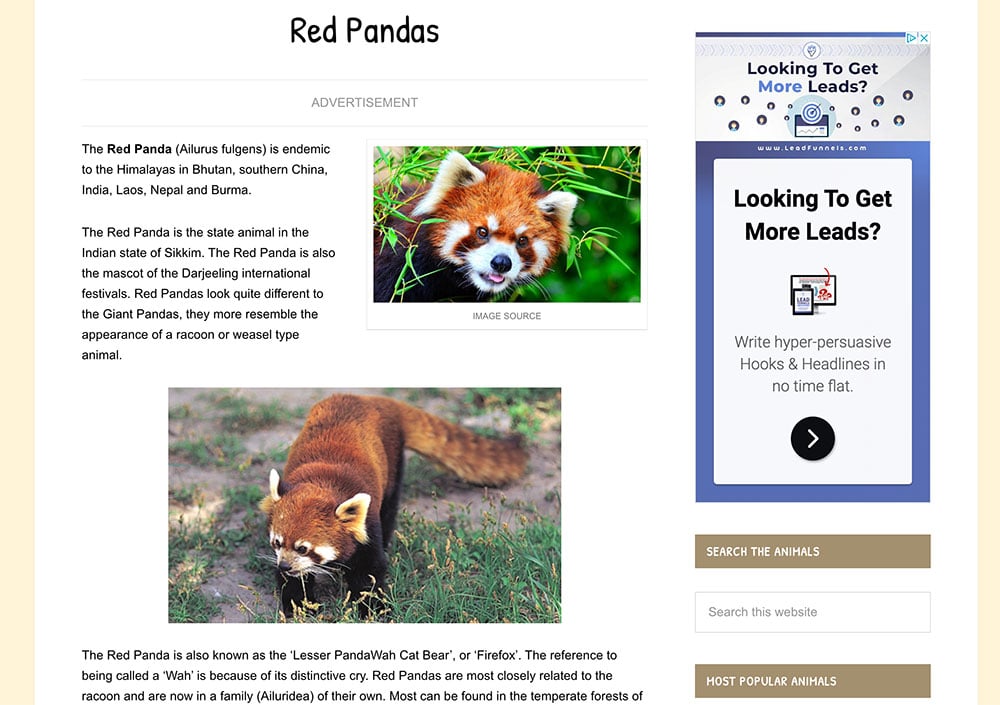
To combat that issue, many publishers started to introduce ads in the middle of the content. You can break up the content with ads. This helps to keep readers on track while also giving them a non-obtrusive ad to look at.
Digital marketing isn’t just used on home pages. Some sites like to keep home pages relatively ad-free so that visitors aren’t turned off before they even get a chance to explore the content. This also helps to get around things like ad blockers and other censoring programs.
News sites, in particular, like to implement ads on individual single pages. For example, they may include advertisements on story pages while keeping the homepage clean.
Ad Placement and Web Design
Digital marketing has a big impact on overall web design. Obviously, designers are focused on creating the best-looking site possible. They work hard to develop branding and create a cohesive look throughout the site.
With that said, sites rely on that advertisement space to make money. So developers often have to keep ads in mind when planning layouts and color schemes. The problem, however, is that designers don’t know which ads will appear on the screen for users. So, they have to be proactive.
Planning the Proper Flow
The most important part of a designer’s job is to ensure that a site has the proper flow. It’s all about where the visitors’ eyes fall on the page whenever it loads. The page needs to direct visitors to the digital content while still making ads visible.
To achieve this, designers will create ad space in many different spots around the core content. They may put it on the header, in small areas within the copy, and on the bottom. As long as it doesn’t impact the way that visitors view the page, it’s bound to be successful.
Future-Proofing Designs
Sometimes, websites don’t sell ads right away. This is pretty common with newer sites that don’t have a ton of traffic just yet. To future-proof the web page, it’s good for designers to create advertising areas ahead of time.
This can be done by designating chunks of space in key areas. Ads can be bunched together so that they are out of the way for the time being.
Keeping Things Neutral
One of the biggest hurdles to get over is color. Online advertisements are often very vibrant. They’re meant to attract attention after all. Unfortunately, too much color on a single page can make it look too busy and overwhelming.
Thus, most developers stick to a neutral color palette. A relatively minimalistic design lets the ads be at the forefront. Plus, it creates an easy separation between the advertisements and the content.
Good Examples of Websites With Ads
If you’re still unsure of how to implement ads into your site, don’t fret. We’ve collected a handful of monetized sites that do the job very well. Use these established sites to gain inspiration and see how strategic digital marketing is done.
The New York Times
The New York Times is a very prominent news site that makes a killing through ad revenue. However, the main goal is to provide daily news to the masses. So, it can’t be covered in ads. Otherwise, it detracts from the story and could affect credibility.
The site solves that problem by keeping things relatively minimal. There are no ads at the header. Aside from images and links to related stories, the bulk of the content is free of digital media as well.
The advertising space is reserved for the sidebar. A substantial portion of digital space is used to display large ads for big-name companies.
Yahoo! Finance
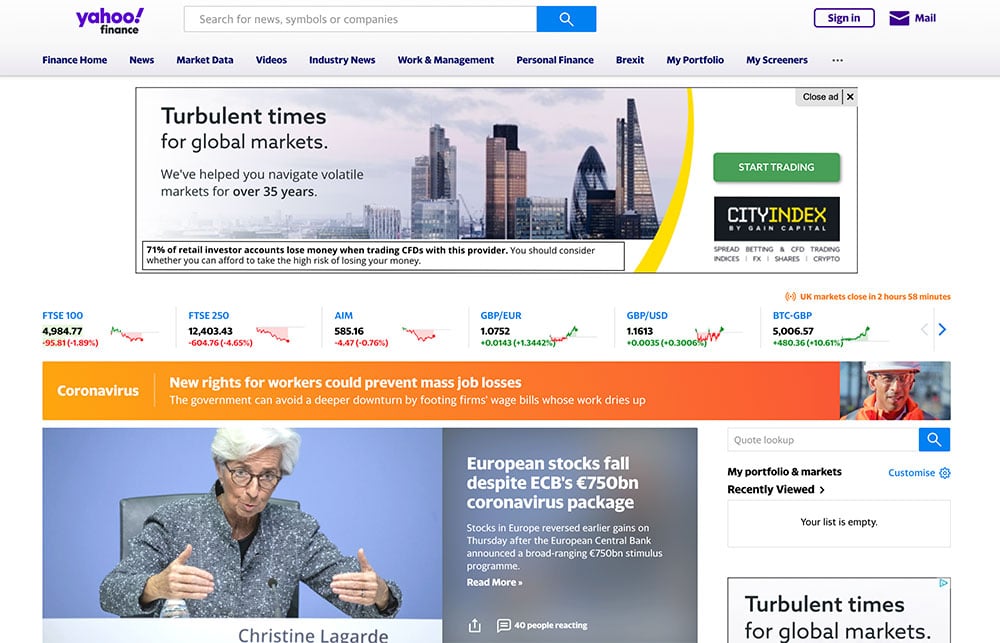
Yahoo! is another trustworthy news source that has to carefully balance content with advertising. One of the ways the developers have seen success is by integrating display ads into the list of available articles.
The homepage shows a collection of articles that visitors can read. However, if you take a look at any recent screenshot, you’ll notice that some of those article titles have an “AdChoice” label next to them. Those are paid ads that are cleverly designed to match the design scheme of the site. It’s unobtrusive, yet very visible.
LifeHacker
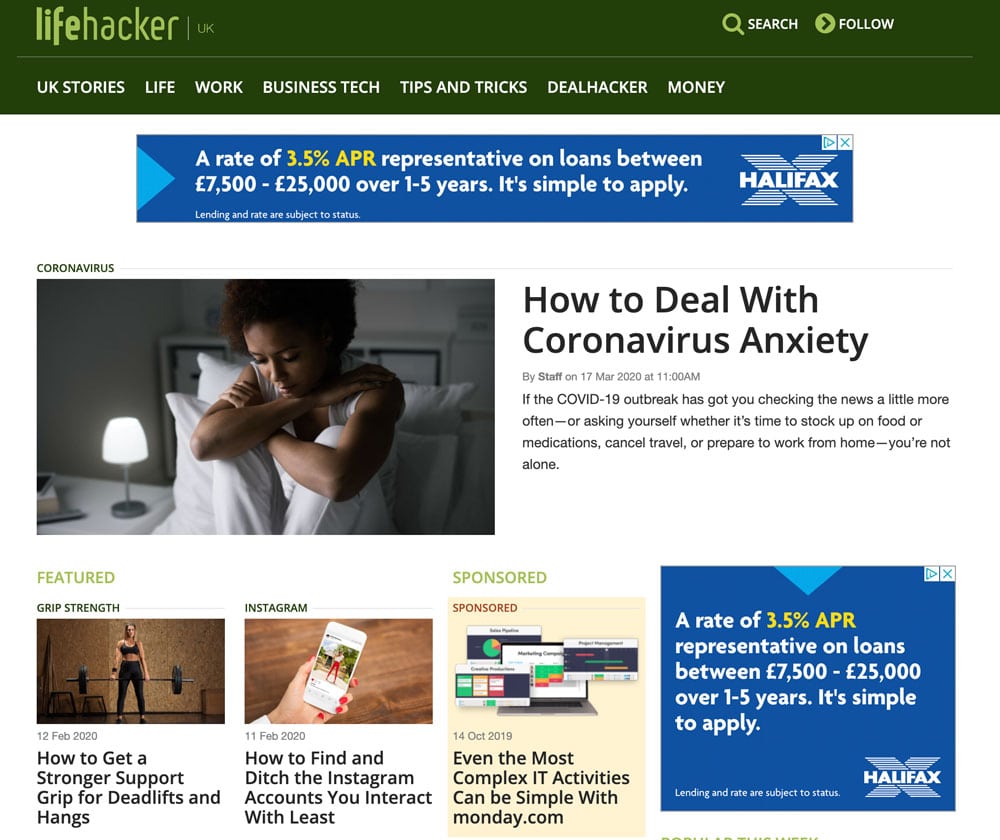
The blog and news site displays AdSense ads front and center for all to see. The ads are located in the header above the main content. While this might seem counterproductive, LifeHacker does it very well by choosing an appropriate size for the site’s design.
The ads are large and quite visible. But, they don’t prevent the content from falling beneath the fold. You can still see the title of the article and view related posts.
Kiplinger
Kiplinger does a great job of incorporating ads into the content without taking away from the user experience. In-content ads can be tricky to do right. Some sites will break up the content entirely with a large banner ad. Kiplinger wraps the text around the ad to manipulate the flow.
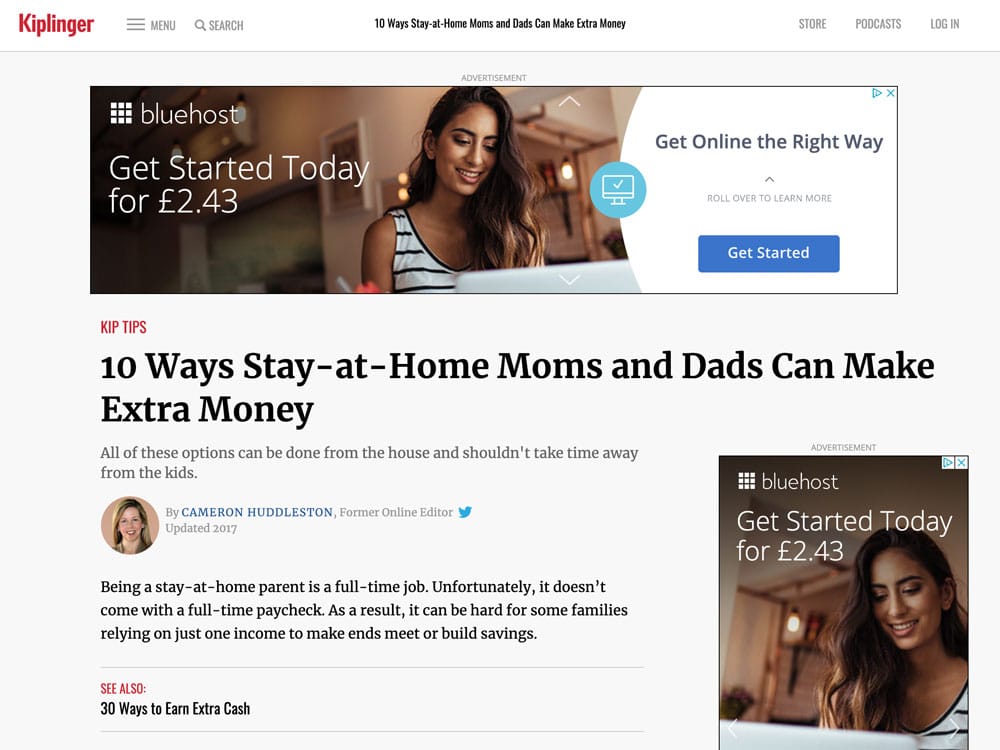
The ads are not subtle. Most are located right in the middle of the page and can’t be missed. However, the fact that you can continue reading uninterrupted makes the placement very effective. It manages to be visible without getting in the way.
They also make good use of the sponsored post method of monetization.

CCS Tricks
This blog uses some old-school advertising tricks in a fresh and modern way. Banner sidebar ads are the digital advertising spots of choice. To make room for those ads, most of the content is shifted to the left of the page. This includes the main copy of the article as well as the links and website logo. This has a couple of advantages.
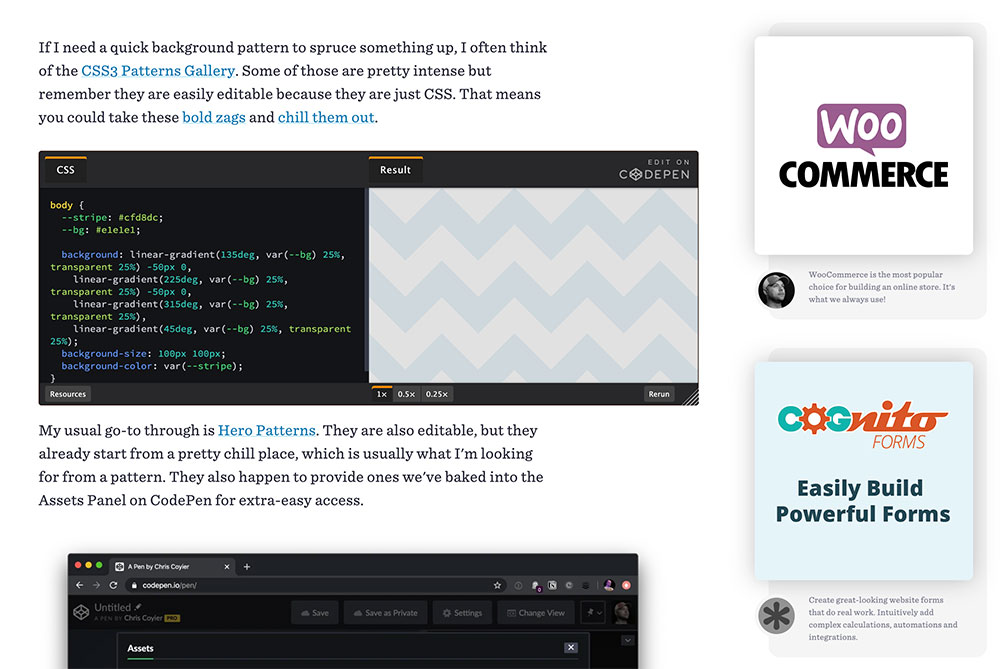
First, the content itself is in a better place to be seen. The eye naturally goes to the left of the page first as if you were reading a book. Second, it provides plenty of space for advertisements on the right. There’s a considerable number of ads on CCS Tricks. But, it’s not annoying because the page is designed so well.
eHow
eHow produces informative articles and step-by-step guides. Thanks to the type of content the site produces, ads well when they’re integrated into content. A lot of the ads on the pages are very simple and designed to look like standard text.
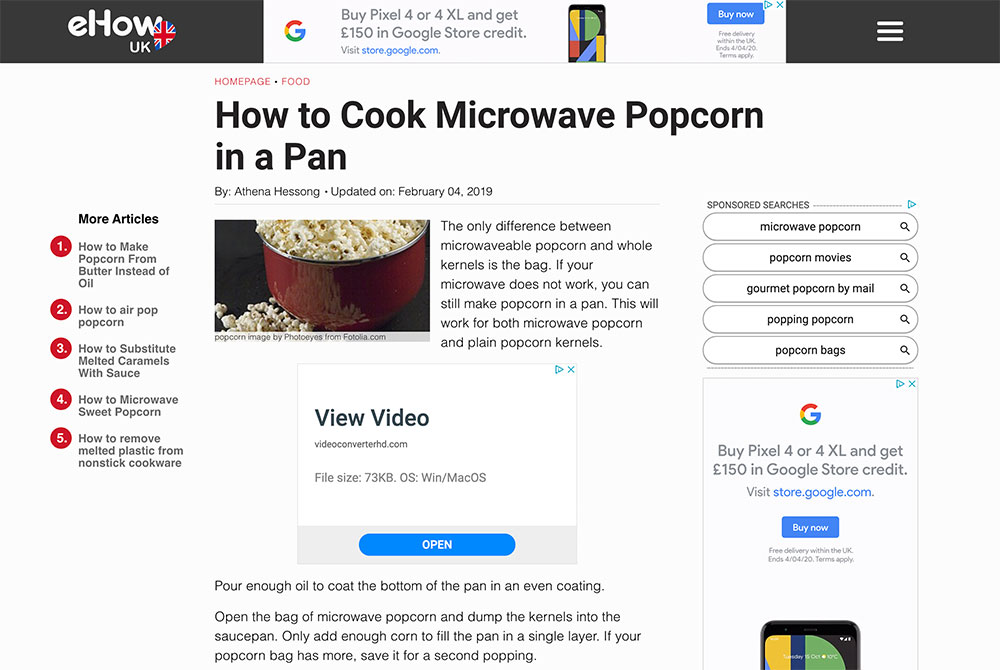
As a result, they appear to be just another part of the guide. It’s a clever way to disguise the ads while ensuring that they are seen.
Reader’s Digest

When you first visit the Reader’s Digest home page, you’re not going to see a ton of ads. There might be an occasional banner towards the bottom of the page. But for the most part, the publisher reserves the home page for its own content.
However, the moment you click on an article, you’ll see several advertisements on a digital page. The site frames its content in ads. There are banners, footers, and ads on both sidebars. The sidebar ads are cleverly blended with related posts and internal links, improving the chances of them being seen.
Conclusion
Displaying website ads is an art form all on its own. You have to maximize the visibility of those ads to increase revenue while sticking to advertising guidelines and maintaining a positive user experience. It might seem tough, but it’s possible.
As you can see from our examples above, many different types of websites can incorporate ads. It’s all about finding that perfect balance. You should always think about ads when you’re designing your website. Leaving them as an afterthought can cause it to look busy or unprofessional.
Jamie Spencer
Latest posts by Jamie Spencer (see all)
- 50+ Ways To Advertise Your Business For Free On The Internet – 2024 Guide - April 5, 2024
- How to Start Your Own Podcast - April 2, 2024
- Uber Stats 2024 – All The Numbers & All The Facts - April 2, 2024

